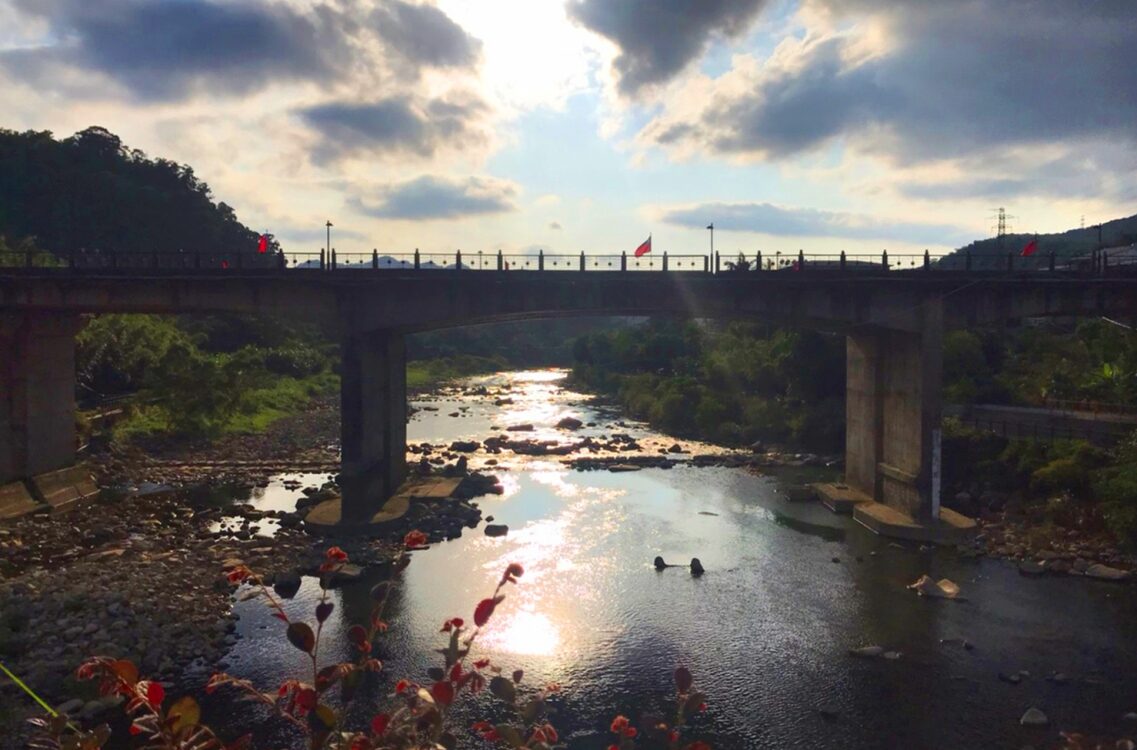上述這段引自《論語》的師生對話,在「河邊洗洗澡,戶外吹吹風,結伴而行的唱唱歌」的回答中,曾點彷彿不著邊際地回答自己的志向,如果這段對話,在遙遠的今日被誤讀是允許的話,這不正如同一個微型自嗨的春吶 1 現場嗎?然而不用像春吶這般激情,在盛夏時光,前往新北市坪林,就有機會在北勢溪畔,遇到一位生活態度,如同「浴乎沂,風乎舞雩,詠而歸」的採集達人――陳科廷。
 陳科廷近年回歸家鄉新北市坪林,結合環境、植耕與藝術,成立了「採集人共作室」,實踐永續生活的價值理念。圖©空總臺灣當代文化實驗場,陳漢聲攝影
陳科廷近年回歸家鄉新北市坪林,結合環境、植耕與藝術,成立了「採集人共作室」,實踐永續生活的價值理念。圖©空總臺灣當代文化實驗場,陳漢聲攝影
上述開場對一位「返鄉青年」來說,是否太不符合這世道所流行的印象了?例如「放棄年薪百萬」、「放棄海外高薪」或「放棄公職鐵飯碗」,上述職業,不是公務人員、醫生、就是科技業工程師或任職於外商公司,如果放棄與重拾是相對而言的選擇與狀態,究竟什麼東西值得被重拾?而什麼東西又是須下定決心才能放棄的?每一個個體都有各自要面對的生存課題,然而就陳科廷的生活狀態而言,究竟「放棄」了什麼?並「重拾」了什麼?
訪談間,可以感受陳科廷的處事節奏與價值實踐,如同他自己創辦的「採集人共作室」名稱所示,充滿著「採集感」與「參與感」,這裡的採集指的並非是課本上,每每在介紹舊石器時代人類生活時所提到的「過著採集、狩獵和漁撈的生活,且已知用火與製作石器」,究竟「採集」意指的是什麼?另外,因「共作」而升起的「參與感」,在相較都市人口較為稀疏的坪林,誰是共作和參與的對象?
在臺灣的升學體制裡,「分類」是一個你我都不陌生的成長歷程,而所謂的美術跟自然(理科生物)科,這兩項在過去的學習歷程中,幾乎是完全不會併在一起思考的科目,學生們在分類時也只能選擇文組或是理組。畢業於國立中興大學植物病理學系研究所的陳科廷也不例外,「我從國中開始就想去考美術班,高中也考過美術班,然後到了大學,但幾次下來都沒有考上。」陳科廷有點自嘲地分享著。
高中升大學時,他開始有所「抉擇」。然而這個抉擇就只是一個生活方式的選擇,不應該構成生命樣態的定局,陳科廷在研究所時期,申請了財團法人國際合作發展基金會的獎學金,被派駐到加勒比海的聖文森及格瑞那丁(Saint Vincent and the Grenadines,簡稱聖文森),並在因緣際會下,原本的職前訓練,順勢成了外交替代役的服役過程。農資學院所養成的專業背景,也讓「植物」成就了這段在聖文森生活近一年的奇遇記。
在加勒比海的一座小島上,陳科廷需要面對哪些挑戰?在聖文森的示範農場實習期間,除了種植技術與技術轉移,更多的時間,陳科廷需要發揮觀察的能力,從田地現場到消費現場,將自身的狀態從農夫調整到產銷人員,從農場移至市場。訪視田地時也要向農民們解說與示範,並在過程中觀察不同風土對作物的影響,從生產端到產銷端,他的角色更像是一個溝通者,穿梭在植物與人之間。
正因為聖文森是面積很小的島國,許多蔬果都仰賴進口,因此長期下來,除了服務來自歐美地區的觀光客,當地人的飲食習慣也逐漸改變,吃起歐美等溫帶地區的蔬菜,因此要如何在熱帶地區種植溫帶蔬果,科廷表示這是當時所要面對的議題,也是日常工作的一環。為此,團隊從臺灣進口耐熱的農作品種到聖文森種植,目的是為了提升當地作物的自給生產率,以降低當地對於進口農產品的仰賴。
除了上述這種關係著國與國之間貿易交流的長遠大計,陳科廷也在不同的海外國家,參與了許多更貼近當地生活的計畫,例如他在帛琉期間,與當地從國小到中學幾乎全國的校園農場合作,希望推廣校方以自己種植且生產蔬菜的方式,來供應學校營養午餐的需求,也進而增加富含營養的蔬菜量與種類,以減少當地孩童的三高問題。帛琉經歷過日本殖民與美國託管的歷史,因此當地的飲食文化也同樣受到外來文化的劇烈影響,原本的主食包含芋頭、地瓜、樹薯等,而在外來影響下,轉變成漢堡、比薩、義大利麵、米食與罐頭肉等。他所參與的計畫目的,便是希望透過校園自耕的營養午餐計畫,讓學生能夠吃到更多當地種植的蔬果,攝取更為均衡健康的食物。

從國與國之間的貿易、到治本於農的治國之道,甚至是學校的經營,都不脫人與農作之間的關係。然而,許多理想的價值實踐,也有許多現實問題需要面對,陳科廷毫不諱言地說到,自己就曾耳聞校園種植的作物,因成效顯著,發生了校方把種植的蔬菜賣給其他社區,將賺到的錢拿去買其他學校用品的情況,最初的美意也因此變質。
至此,可以感受到「農作」與「農藝」,不單只是植物的生長與收成,更攸關了日常生活的各種理念與思考。陳科廷在異國的「學以致用」,除了「種植技術」與「產銷技術」,更重要的是讓他持續關注人與人之間、人與植物之間,在不同文化中的緊密連結與互動關係。
結束了帛琉技術團的工作後,陳科廷申請了龍應台文化基金會「思想地圖計畫」,針對帛琉芋頭文化進行研究;返臺後,他也直接加入了林試所研究員董景生博士主持的蘭嶼民族植物研究計畫團隊,協助調查達悟族的芋文化。從民族植物學的觀點,以及之後他任職林業試驗所期間,在臺北植物園南門町三二三的工作與展覽經驗,無不啟發陳科廷結合藝術跟植物的想法,又或者說,他在經歷研究所、實習與服役的歷練,符合學以致用的「專業」似乎已逐漸成形,並順利地銜接到他的職業路徑。而藝術創作的初衷,也如同被催芽般重新被喚醒,他在這幾年間也陸續參與了許多展覽,並結合校園學習資源,並在2021年底完成了「茶山尋怪:坪林地方學課程成果展」(簡稱「茶山尋怪」)。
為了採訪「茶山尋怪」一展,遠離城市的紛擾,搖下車窗,窗外逐漸增加的綠意,讓人一度忘卻當天其實是要去看展覽的。坪林區公所旁的坪林農創聚落,是一個連同地下室總共有三個樓層的建物,走過小小的穿廊,左右兩側的小花圃裡,「坪林共生花園」的說名牌已經為這個展覽揭開序幕。
 混種多樣坪林茶樹與臺灣原生植物的「坪林共生花園」。圖©空總臺灣當代文化實驗場,陳漢聲攝影
混種多樣坪林茶樹與臺灣原生植物的「坪林共生花園」。圖©空總臺灣當代文化實驗場,陳漢聲攝影
「茶山尋怪」一展使用建築的地下室與二樓作為展出空間。沿著走道,我們先進入到地下室的展間,是一個近乎全黑的展場,隨著步伐移動,腳下的枯葉聲,讓人有著在森林般的感受,空間裡樹立著幾根竹子,上頭掛著一些圖像與紙張,這些物件,是展覽的參與者透過工作坊所製作的怪物面具與說明,穿梭其間彷彿在此探險、打怪,或見鬼?
「積水怪、聽雨生、山隧妖、慢慢怪、拔樹怪、透明遊俠……」這些不知名的妖魔鬼怪,在目擊者、日期、地點與描述解說的文件中,有如口供一般地提供給觀者最「真實的」證據,而這些鬼怪都來自於坪林學童將日常生活中所遇到「困擾」擬人化而成。包含路面下的集雨排水道,下雨時會匯集路面的污水,排放到河川之中,在國中路下方的馬路縫隙,成為了「聽雨生」;「積水怪」出現在沒有人注意到的地面或凹陷處、容器內,指的是人造地的水窪,暗示著孩童們對於環境清潔的期盼;「山隧妖」則被賦予了不太喜歡環境開發的個性設定,並且在坪林旁邊的雪山隧道和北宜公路一帶出沒,「開挖雪隧的過程中曾經發生意外,導致工人被壓死,才產生這隻妖怪。」山隧妖投射出對於環境開發的排斥、甚至質疑。「茶山尋怪」一展中的「怪物」,是坪林的真實事件與日常,也是童言童語「真實發聲」在作品中,將這些平日難以描述的「日常困難」能夠在此被分享與傾聽。
 行走在「茶山尋怪」地下室的黝暗展間,滿地落葉中的「怪物」,轉化自坪林的真實事件與日常。圖©空總臺灣當代文化實驗場,陳漢聲攝影
行走在「茶山尋怪」地下室的黝暗展間,滿地落葉中的「怪物」,轉化自坪林的真實事件與日常。圖©空總臺灣當代文化實驗場,陳漢聲攝影
 來到「茶山尋怪」的二樓展間,一旁的窗景透著陽光,有著藍曬的植物圖像自窗間灑落。圖©空總臺灣當代文化實驗場,陳漢聲攝影
來到「茶山尋怪」的二樓展間,一旁的窗景透著陽光,有著藍曬的植物圖像自窗間灑落。圖©空總臺灣當代文化實驗場,陳漢聲攝影
順著樓梯,我們來到了二樓展間,一旁的窗景透著陽光,有著藍曬的植物圖像灑落,而大型的藍曬布幔垂掛,形構了主展場的視覺,每一條布幔都搭配著一個標本箱構造的木作,觀者很快地可以意識到,藍曬上的印花,是參與者透過剪接、裁剪、塑形與改造的物件所曬出來的「痕跡」。
一幅藍曬布幔上,有一位身著護士裝的全身像,身旁佈滿著兒童的臉龐,護士的其中一隻眼睛裡,有著彷彿超音波照出來的胎兒剪影,這位是「掌握生命的坪林阿嬤」,科廷跟我們講述著坪林地方那位擁有助產士執照的蔡巧阿媽的故事。
「虎字碑、雙扇蕨、石砌的土地神小廟……散落在一條綿延彎曲的路徑上」,參與者將淡蘭古道作為重要的運輸要道的歷史映入圖中,也藉此見證坪林過去的發展軌跡。每一個地方因為有人真實在此生活,透過痕跡的保存,建構自己、認識自己,也有機會進一步介紹自己,讓他者認識。「茶山尋怪」展透過地方居民的加入,建構了專是一屬坪林才有的故事與記憶,也讓坪林不只個地名而已,而是一個活生生的生活場域,對應著地下室的妖怪傳說,訴說著這片土地上的經驗與記憶傳承。
 藍曬圖中講述了坪林地方助產士蔡巧阿媽的故事。圖©空總臺灣當代文化實驗場,陳漢聲攝影
藍曬圖中講述了坪林地方助產士蔡巧阿媽的故事。圖©空總臺灣當代文化實驗場,陳漢聲攝影
 雙扇蕨也叫雙葉蕨,在淡蘭古道隨處可見,因此被選作古道象徵符號。圖©空總臺灣當代文化實驗場,陳漢聲攝影
雙扇蕨也叫雙葉蕨,在淡蘭古道隨處可見,因此被選作古道象徵符號。圖©空總臺灣當代文化實驗場,陳漢聲攝影
故鄉與地方,隨著自己所處的位置與狀態而有所差異,生活在臺灣,小小的臺灣被分成南北,小小的臺北,又被分成蛋黃區與蛋白區。然而,從國外回到臺灣,為何最後還是選擇回到坪林並成立「採集人共作室」呢?
 陳科廷希望透過回到自己最初的起點坪林生活,也回歸與人、與植物的交流關係。圖©空總臺灣當代文化實驗場,陳漢聲攝影
陳科廷希望透過回到自己最初的起點坪林生活,也回歸與人、與植物的交流關係。圖©空總臺灣當代文化實驗場,陳漢聲攝影
「可能是因為曾經在聖文森跟帛琉工作的關係,我觀察到當地生活的人,仍保有作為一個人應該要擁有的能力,例如自己種植、自己採集等。生活裡的很多事情,其實還是需要保有身而為人所應有的技能。」科廷分享著自己的想法,並進一步地談起為何想回到坪林的原因。「便利的社會,讓人們喪失了很多技能,連走路移動的技能都可能失去,因此我第一時間想到的是回到一個比較樸實的地方去生活。」在結束植物園的工作後,科廷才慢慢地「返鄉」,慢慢地找到自己「想要的狀態」。
「現在會覺得,沒有一開始就念美術或許是件好事。」陳科廷的求學階段有許多看似妥協的抉擇,但仍在過程中,埋下了種子,那種對創作仍然嚮往的種子,在科廷的身上,我們並不會感受到太多所謂的「放棄」與「重拾」,而是在回到坪林後,有更多屬於人性的回歸,在與人、與植物的交流,甚至是與生態交流的關係中,才有機會被看見。